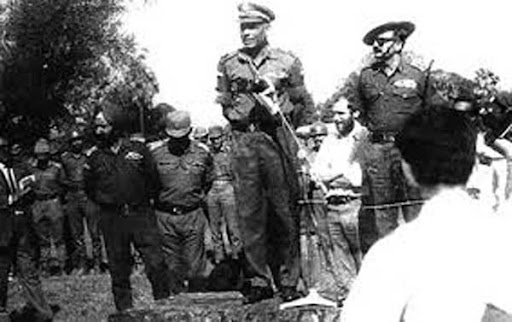Often our history books are replete with stories of indomitable courage, valour, and tenacity in the face of crisis exhibited by the men in uniform. However, one such gentleman named Major General Sagat Singh Rathore — the only military officer to have won three big battles in his decorated career was skipped unceremoniously by the history books. Although, better late than never, the Indian Army is making General Sagat a part of the public memory by celebrating his achievements. In 2019, on his birth centenary, a commemorative ceremony was held at Mehrangarh, and his bust was also unveiled.
Under General Sagat’s leadership, Goa was liberated from Portugal. In the year 1967, a tremendous attack from the rampaging Chinese army was stopped in Nathu-La while in the Indo-Pak war of 1971, bypassing the orders of his senior officers, General Sagat went to Dhaka. This forced the Pakistani army to lay down its arms which ultimately led to the surrender of 93,000 Pak soldiers.
Nathu-La pass and India’s victory over the Chinese
6 September 1967, at the frigid cold altitude of 14,200 feet, seventy Chinese soldiers intruded across India’s northern border south of Nathu La in Sikkim. The Chinese army started firing indiscriminately without any warning. Indian soldiers were left exposed in the open and as a result, a large number of soldiers were killed.
After this, General Sagat brought up the artillery guns from the lower altitudes. At that time, only the Prime Minister could give orders to fire the heavy artillery guns. However, after receiving no orders or clarity from Delhi, General Sagat took matters into his own hands and ordered the firing of guns.
Chinese soldiers, who till the time were on an ascendency were suddenly forced to scurry around, looking for cover. In addition to the weaponry, the Indian soldiers fought brutal hand-to-hand battles at the pass. In the end, Nathu La Pass remained firmly in the control of the Indian Army. A few weeks later another attack at Cho Pass, northwest of Nathu La, was similarly repulsed. The Chinese forces met more than their match and eventually backed off.
New York Times whilst describing the events of the battle remarked, “In the Natu pass incident, Chinese causalities were estimated unofficially as 600 and Indian losses as at least half of that.”
The victory at Nathu La was not only militarily important, but it was also important in the context of the tenacity of one officer – Major General Sagat Singh. During the Indo Pak War of 1965, China threatened to open a parallel front in the protectorate state of Sikkim and ordered India to vacate two mountain passes – Zelep La and Nathu La. Both were strategically important, and both gave India a strategic advantage over China, just like in the case of Haji Pir.
However, unlike the disaster of Haji Pir, Major General Sagat Singh stood his ground and said that he was ready to face the court-martial, but he wouldn’t vacate Nathu La. Not only did that decision save Sikkim, but also it led to India’s victory. It erased the painful memories of 1962 and gave the belief that Indian forces could one-up the Chinese. However, even after giving a masterclass of tactics and war preparedness, General Sagat was transferred from here.
Read more: The victory of Haji Pir Pass – A battle India won on ground, but lost on the table
Freeing Goa from the Portuguese
In order to free Goa from Portuguese occupation, the three wings of the Indian Army, the land, the air, and the navy, carried out a joint operation. According to Major General VK Singh in his biography, 50 Para was selected as an ally in Operation Vijay of the Indian Army in December 1961 for the liberation of Goa.
On 18 December, 50 Para landed in Goa. On 19 December Major General Sagat’s battalion reached near Goa. After camping all night outside Panaji, his men swam across the river and entered the city. It was he who forced the Portuguese to surrender. 3306 people surrendered, including Portuguese soldiers. With this, the Portuguese rule over Goa, which had been running for 451 years came to an end and the western state became a part of the Union of India.
Indo-Pak war 1971
During the Indo-Pak war of 1971, General Sagat attacked then East Pakistan from the Agartala sector and continued to move forward with his army. General Arora ordered them not to cross the Meghna river. But with the help of helicopters, General Sagat unloaded the entire brigade across the four kilometres wide Meghna river and moved on. The country’s then-Defence Minister Babu Jagjivan Ram and PM Indira Gandhi were astonished that how the Indian Army managed to reach Dhaka so quickly.
The Indian army under the leadership of General Sagat surrounded Dhaka and sent a message of surrender to General Niazi. And what happened afterwards is a memory cherished by every single Indian across the country. However, despite playing such a pivotal part in the liberation of Bangladesh, General Sagat remained an unsung warrior.
The only warrior to defeat Portugal, China, and Pakistan — Sagat Singh took wars and battles in the enemy’s camp and won them by forcing the opponent into surrender. Such was his authority; such was his bravery and yet not many of us would have heard about him. It’s time that the history books give him his due credit and the appreciation he so richly deserves.
